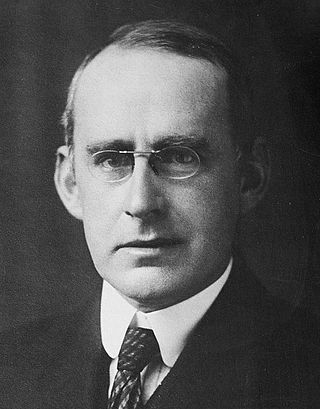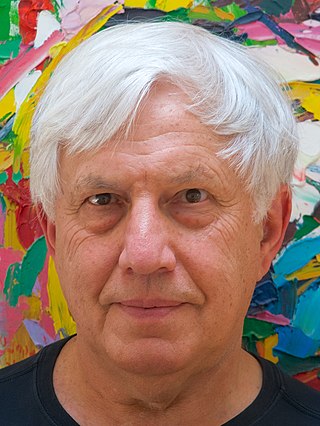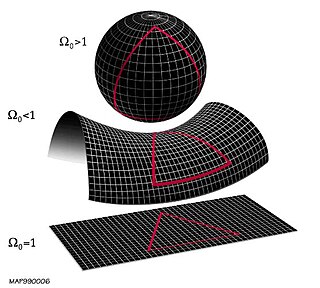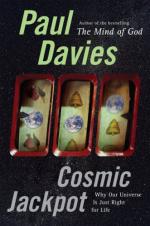The anthropic principle, also known as the observation selection effect, is the hypothesis that the range of possible observations that could be made about the universe is limited by the fact that observations are only possible in the type of universe that is capable of developing intelligent life. Proponents of the anthropic principle argue that it explains why the universe has the age and the fundamental physical constants necessary to accommodate intelligent life. If either had been significantly different, no one would have been around to make observations. Anthropic reasoning has been used to address the question as to why certain measured physical constants take the values that they do, rather than some other arbitrary values, and to explain a perception that the universe appears to be finely tuned for the existence of life.

The multiverse is the hypothetical set of all universes. Together, these universes are presumed to comprise everything that exists: the entirety of space, time, matter, energy, information, and the physical laws and constants that describe them. The different universes within the multiverse are called "parallel universes", "flat universes", "other universes", "alternate universes", "multiple universes", "plane universes", "parent and child universes", "many universes", or "many worlds". One common assumption is that the multiverse is a "patchwork quilt of separate universes all bound by the same laws of physics."

In cosmology, the cosmological constant, alternatively called Einstein's cosmological constant, is a coefficient that Albert Einstein initially added to his field equations of general relativity. He later removed it; however, much later it was revived to express the energy density of space, or vacuum energy, that arises in quantum mechanics. It is closely associated with the concept of dark energy.

The triple-alpha process is a set of nuclear fusion reactions by which three helium-4 nuclei are transformed into carbon.

Lee Smolin is an American theoretical physicist, a faculty member at the Perimeter Institute for Theoretical Physics, an adjunct professor of physics at the University of Waterloo, and a member of the graduate faculty of the philosophy department at the University of Toronto. Smolin's 2006 book The Trouble with Physics criticized string theory as a viable scientific theory. He has made contributions to quantum gravity theory, in particular the approach known as loop quantum gravity. He advocates that the two primary approaches to quantum gravity, loop quantum gravity and string theory, can be reconciled as different aspects of the same underlying theory. He also advocates an alternative view on space and time that he calls temporal naturalism. His research interests also include cosmology, elementary particle theory, the foundations of quantum mechanics, and theoretical biology.
Frank Jennings Tipler is an American mathematical physicist and cosmologist, holding a joint appointment in the Departments of Mathematics and Physics at Tulane University. Tipler has written books and papers on the Omega Point based on Pierre Teilhard de Chardin's religious ideas, which he claims is a mechanism for the resurrection of the dead. He is also known for his theories on the Tipler cylinder time machine. His work has attracted criticism, most notably from Quaker and systems theorist George Ellis who has argued that his theories are largely pseudoscience.
In physics, a dimensionless physical constant is a physical constant that is dimensionless, i.e. a pure number having no units attached and having a numerical value that is independent of whatever system of units may be used.

In astrophysics, the Eddington number, NEdd, is the number of protons in the observable universe. Eddington originally calculated it as about 1.57×1079; current estimates make it approximately 1080.

In theoretical physics, the hierarchy problem is the problem concerning the large discrepancy between aspects of the weak force and gravity. There is no scientific consensus on why, for example, the weak force is 1024 times stronger than gravity.

Andrei Dmitriyevich Linde is a Russian-American theoretical physicist and the Harald Trap Friis Professor of Physics at Stanford University.
In theoretical physics, fine-tuning is the process in which parameters of a model must be adjusted very precisely in order to fit with certain observations.

The flatness problem is a cosmological fine-tuning problem within the Big Bang model of the universe. Such problems arise from the observation that some of the initial conditions of the universe appear to be fine-tuned to very 'special' values, and that small deviations from these values would have extreme effects on the appearance of the universe at the current time.

The Dirac large numbers hypothesis (LNH) is an observation made by Paul Dirac in 1937 relating ratios of size scales in the Universe to that of force scales. The ratios constitute very large, dimensionless numbers: some 40 orders of magnitude in the present cosmological epoch. According to Dirac's hypothesis, the apparent similarity of these ratios might not be a mere coincidence but instead could imply a cosmology with these unusual features:
In string theory, the string theory landscape is the collection of possible false vacua, together comprising a collective "landscape" of choices of parameters governing compactifications.
Cosmological natural selection, also called the fecund universes, is a hypothesis proposed by Lee Smolin intended as a scientific alternative to the anthropic principle. It addresses why our universe has the particular properties that allow for complexity and life. The hypothesis suggests that a process analogous to biological natural selection applies at the grandest of scales. Smolin first proposed the idea in 1992 and summarized it in a book aimed at a lay audience called The Life of the Cosmos, published in 1997.

The Boltzmann brain thought experiment suggests that it might be more likely for a single brain to spontaneously form in space, complete with a memory of having existed in our universe, rather than for the entire universe to come about in the manner cosmologists think it actually did. Physicists use the Boltzmann brain thought experiment as a reductio ad absurdum argument for evaluating competing scientific theories.

Cosmic Jackpot, also published under the title The Goldilocks Enigma: Why is the Universe Just Right for Life?, is a 2007 non-fiction book by physicist and cosmologist Paul Davies, describing the idea of a fine-tuned universe.

In cosmology, the cosmological constant problem or vacuum catastrophe is the substantial disagreement between the observed values of vacuum energy density and the much larger theoretical value of zero-point energy suggested by quantum field theory.
Alejandro Jenkins is a Costa Rican theoretical physicist. He is currently a professor at the University of Costa Rica and a member of Costa Rica's National Academy of Sciences. He has worked on applications of quantum field theory to particle physics and cosmology, as well as on self-oscillating dynamical systems and quantum thermodynamics.

The Cosmic Landscape is a non-fiction popular science book on the anthropic principle and string theory landscape. It is written by theoretical physicist Leonard Susskind. The book was initially published by Little, Brown and Company on December 12, 2005.













